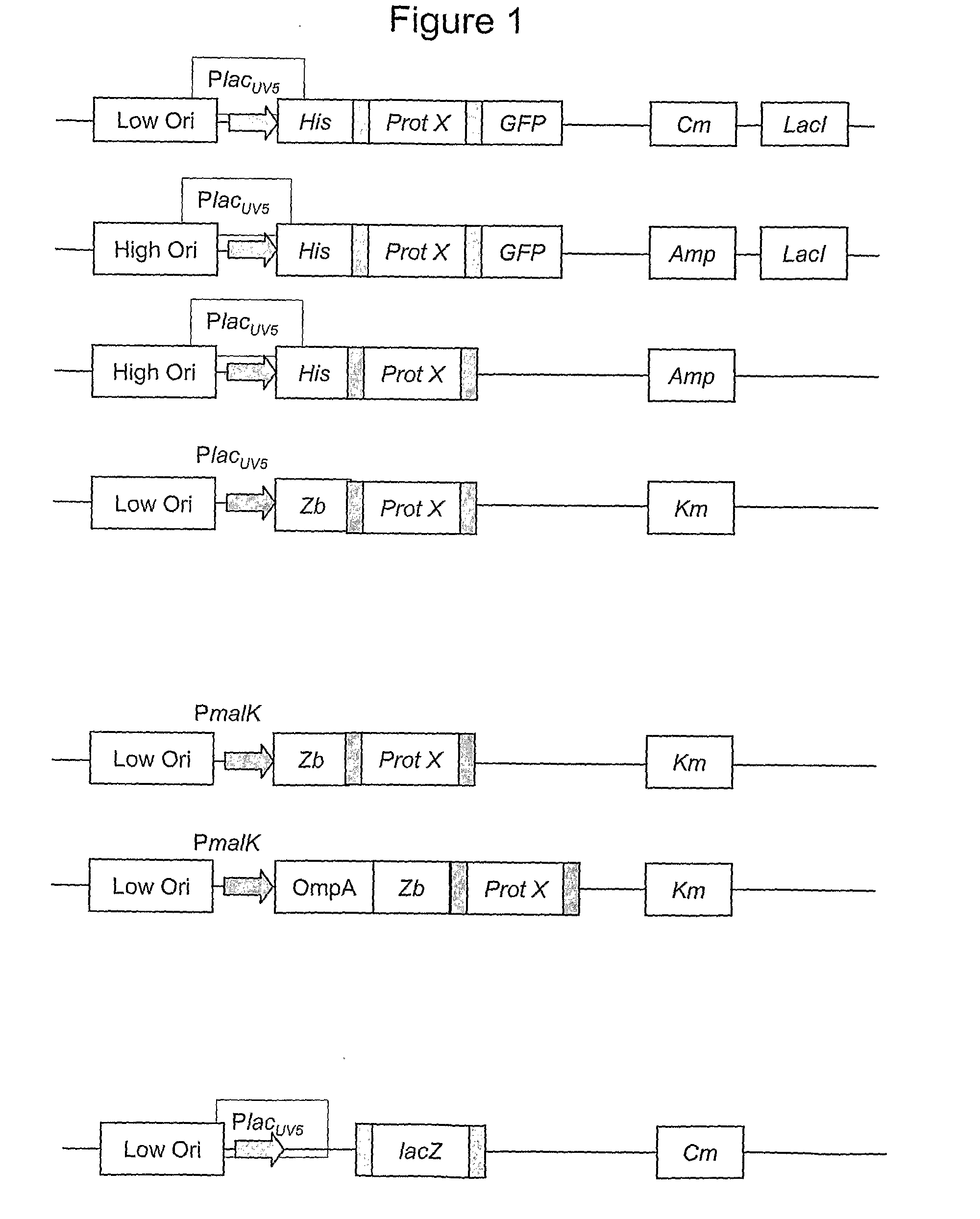Method for Multiparallel Construction of Host/Vector-Systems for Expression of Proteins
a technology of host/vector system and protein, applied in the field of cell engineering, can solve the problems of avoiding the need for extensive monitoring and control of culture parameters, and restricting the availability of critical substrates for cells, etc., and achieves the effect of reducing the activity, performance or expression of that member and reducing the efficiency of the uptake system
- Summary
- Abstract
- Description
- Claims
- Application Information
AI Technical Summary
Benefits of technology
Problems solved by technology
Method used
Image
Examples
example 1
[0061]Materials and Methods
[0062]Plasmid and Model Protein
[0063]To get a desired product protein a plasmid with suitable genes can be transformed into the bacteria. This particular example used the plasmid pAF1016 (PlacUV5-lacZ, CmR) that has a lacUV5 promoter and produces the enzyme β-galactosidase. The plasmid was constructed by A. Farewell, Univ. of Gothenburg, for the EU Framework IV project “Control and optimisation of bottlenecks in recombinant protein production by Escherichia coli” or COOP. The recombinant protein produced was β-galactosidase.
[0064]β-Galactosidase
[0065]The E. coli enzyme β-galactosidase (5-gal) (encoded by the lacZ gene) is a tetramer consisting of four identical sub-units, each consisting of 1023 amino acid residues (Kalnins et al, 1983). It was chosen as the model protein because of its intracellular location, proteolytic stability, solubility at high concentrations, and ease of analysis. β-galactosidase hydrolyses lactose and other β-galactosides into mon...
example 2
[0117]Materials and Methods
[0118]Strains and Vectors
[0119]Escherichia coli, AF1000 was used in all experiments (Sandén A M et al, 2002). Three mutations were used which are all situated in the genes for expression of the phosphoenolpyruvate:carbohydrate phosphotransferase system (PTS) and results in a reduced uptake rate of glucose (Picon A et al, 2005). The three strains are defect in either the enzymes IICBGlc (ptsG), IIABMan (manX) or both. These strains will hereafter be referred to as PTSGlc, PTSMan and PTSGlcMan, respectively. The construction of the present strains was described elsewhere (Sandén A M et al, 2002, Picon A et al, 2005). All strains and plasmids are listed in Table 5.
TABLE 5Summary of Escherichia coli strainsand plasmids used in this example.Source / Strain / plasmidRelevant characteristicsreferenceAF1000MC4100, relA+, wild-typeA. FarewellPPA668AF1000, ΔmanX, zea3068::Tn10A. PiconPPA652AF1000, ΔptsG::KmA. PiconPPA689PPA668, ΔptsG::KmA. PiconF′lacIq, lacY, lacA, TnRA...
PUM
| Property | Measurement | Unit |
|---|---|---|
| Fraction | aaaaa | aaaaa |
| Electrical resistance | aaaaa | aaaaa |
| Strain point | aaaaa | aaaaa |
Abstract
Description
Claims
Application Information
 Login to View More
Login to View More - R&D
- Intellectual Property
- Life Sciences
- Materials
- Tech Scout
- Unparalleled Data Quality
- Higher Quality Content
- 60% Fewer Hallucinations
Browse by: Latest US Patents, China's latest patents, Technical Efficacy Thesaurus, Application Domain, Technology Topic, Popular Technical Reports.
© 2025 PatSnap. All rights reserved.Legal|Privacy policy|Modern Slavery Act Transparency Statement|Sitemap|About US| Contact US: help@patsnap.com



